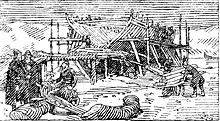Battle of the Helgeå
| Battle of the Helgeå | |||||||
|---|---|---|---|---|---|---|---|
 Olav den helliges saga GM15 |
|||||||
|
|||||||
| Belligerents | |||||||
| Anglo-Danish kingdom |
Sweden Norway |
||||||
| Commanders and leaders | |||||||
|
Cnut the Great Ulf the Earl |
Anund Jacob Olaf Haraldsson |
||||||
| Strength | |||||||
| ~600 ships | ~480 ships | ||||||
| Casualties and losses | |||||||
| Heavy | Minimal | ||||||
Battle of the Helgeå (Norwegian: Slaget ved Helgeå, Swedish: Slaget vid Helgeå) was a naval engagement which took place during 1026, between joint Danish and English forces and a combined Norwegian and Swedish force, at the estuary of a river called Helgeå in Sweden.
King Olaf II of Norway and King Anund Jakob of Sweden took advantage of the commitment of Danish King Cnut to England and began to launch attacks on the Danish in the Baltic Sea. The Swedish and Norwegian navies led by kings Anund Jacob and Olaf II lay in wait up a river for the navy of King Cnut, which was commanded by Danish earl Ulf Jarl.
Cnut's navy was massive and his own ship is said to have been 80 metres long. The Swedish and the Norwegian kings ordered a large dam made of peat and lumber on the river. When the Danish navy sailed in, the water was released and a great many Danes and Englishmen drowned in the deluge. However, the main strength of Cnut's fleet lay outside the river harbour. After the ships in the harbour being destroyed, the rest of the fleet gathered together from all quarters. The kings Olaf and Anund, seeing they had for this time got all the victory that fate permitted them to gain, let their ships retreat. If the battle was renewed, they must suffer a great loss of men, because Cnut had more ships. King Cnut did not pursue them.
The Pyrrhic victory left Cnut as the dominant leader in Scandinavia. At some time after the battle, Cnut subjugated the core provinces of Sweden around Lake Mälaren where he had his own coins minted in Sigtuna.
The battle is retold in skaldic poetry and in sources such as the Danish Gesta Danorum by Saxo Grammaticus and the Icelandic Saga of Olaf the Holy by Snorri Sturluson. Opinions are divided on whether the location was at Helgeå in Uppland or the Helgeå of eastern Skåne.
...
Wikipedia
